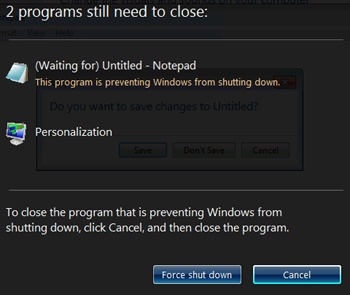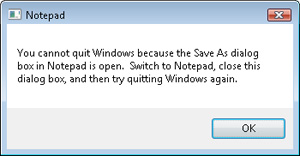Troubleshooting Windows Startup and Shutdown Problems
- By Mark E. Russinovich, Kate Chase, Alex Ionescu
- 9/15/2012
Shutdown
If someone is logged on and a process initiates a shutdown by calling the Windows ExitWindowsEx function, a message is sent to that session’s Csrss instructing it to perform the shutdown. Csrss in turn impersonates the caller and sends an RPC message to Winlogon, telling it to perform a system shutdown. Winlogon then impersonates the currently logged-on user (who might or might not have the same security context as the user who initiated the system shutdown) and calls ExitWindowsEx with some special internal flags. Again this call causes a message to be sent to the Csrss process inside that session, requesting a system shutdown.
This time, Csrss sees that the request is from Winlogon and loops through all the processes in the logon session of the interactive user (again, not the user who requested a shutdown) in reverse order of their shutdown level. A process can specify a shutdown level, which indicates to the system when it wants to exit with respect to other processes, by calling SetProcessShutdownParameters. Valid shutdown levels are in the range 0 through 1023, and the default level is 640. Explorer, for example, sets its shutdown level to 2 and Task Manager specifies 1. For each process that owns a top-level window, Csrss sends the WM_QUERYENDSESSION message to each thread in the process that has a Windows message loop. If the thread returns TRUE, the system shutdown can proceed. Csrss then sends the WM_ENDSESSION Windows message to the thread to request it to exit. Csrss waits the number of seconds defined in HKCU\Control Panel\Desktop\HungAppTimeout for the thread to exit. (The default is 5,000 milliseconds.)
If the thread doesn’t exit before the timeout, Csrss fades out the screen and displays the hung-program screen shown in Figure 13-11. (You can disable this screen by creating the registry value HKCU\Control Panel\Desktop\AutoEndTasks and setting it to 1.) This screen indicates which programs are currently running and, if available, their current state. Windows indicates which program isn’t shutting down in a timely manner and gives the user a choice of either killing the process or aborting the shutdown. (There is no timeout on this screen, which means that a shutdown request could wait forever at this point.) Additionally, third-party applications can add their own specific information regarding state—for example, a virtualization product could display the number of actively running virtual machines.

Figure 13-11 Hung program screen
If the thread does exit before the timeout, Csrss continues sending the WM_QUERYENDSESSION/WM_ENDSESSION message pairs to the other threads in the process that own windows. Once all the threads that own windows in the process have exited, Csrss terminates the process and goes on to the next process in the interactive session.
If Csrss finds a console application, it invokes the console control handler by sending the CTRL_LOGOFF_EVENT event. (Only service processes receive the CTRL_SHUTDOWN_EVENT event on shutdown.) If the handler returns FALSE, Csrss kills the process. If the handler returns TRUE or doesn’t respond by the number of seconds defined by HKCU\Control Panel\Desktop\WaitToKillAppTimeout (the default is 20,000 milliseconds), Csrss displays the hung-program screen shown in Figure 13-11.
Next, Winlogon calls ExitWindowsEx to have Csrss terminate any COM processes that are part of the interactive user’s session.
At this point, all the processes in the interactive user’s session have been terminated. Wininit next calls ExitWindowsEx, which this time executes within the system process context. This causes Wininit to send a message to the Csrss part of session 0, where the services live. Csrss then looks at all the processes belonging to the system context and performs and sends the WM_QUERYENDSESSION/WM_ENDSESSION messages to GUI threads (as before). Instead of sending CTRL_LOGOFF_EVENT, however, it sends CTRL_ SHUTDOWN_EVENT to console applications that have registered control handlers. Note that the SCM is a console program that does register a control handler. When it receives the shutdown request, it in turn sends the service shutdown control message to all services that registered for shutdown notification. For more details on service shutdown (such as the shutdown timeout Csrss uses for the SCM), see the “Services” section in Chapter 4 in Part 1.
Although Csrss performs the same timeouts as when it was terminating the user processes, it doesn’t display any dialog boxes and doesn’t kill any processes. (The registry values for the system process timeouts are taken from the default user profile.) These timeouts simply allow system processes a chance to clean up and exit before the system shuts down. Therefore, many system processes are in fact still running when the system shuts down, such as Smss, Wininit, Services, and LSASS.
Once Csrss has finished its pass notifying system processes that the system is shutting down, Winlogon finishes the shutdown process by calling the executive subsystem function NtShutdownSystem. This function calls the function PoSetSystemPowerState to orchestrate the shutdown of drivers and the rest of the executive subsystems (Plug and Play manager, power manager, executive, I/O manager, configuration manager, and memory manager).
For example, PoSetSystemPowerState calls the I/O manager to send shutdown I/O packets to all device drivers that have requested shutdown notification. This action gives device drivers a chance to perform any special processing their device might require before Windows exits. The stacks of worker threads are swapped in, the configuration manager flushes any modified registry data to disk, and the memory manager writes all modified pages containing file data back to their respective files. If the option to clear the paging file at shutdown is enabled, the memory manager clears the paging file at this time. The I/O manager is called a second time to inform the file system drivers that the system is shutting down. System shutdown ends in the power manager. The action the power manager takes depends on whether the user specified a shutdown, a reboot, or a power down.

